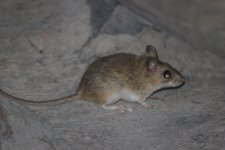opisska
rabid twitcher

Small rodents are the most mysterious creatures of the world. You see one, you open a book and it can be literally anything from a dozen of species! I personally think that Desert Pygmy Mouse fits this quite well, but so do even some small Gerbils (there is no picture of the end of the tail).... heeeeelp!
Taken in Halali, Etosha, in the waterhole viewing area.
Taken in Halali, Etosha, in the waterhole viewing area.




